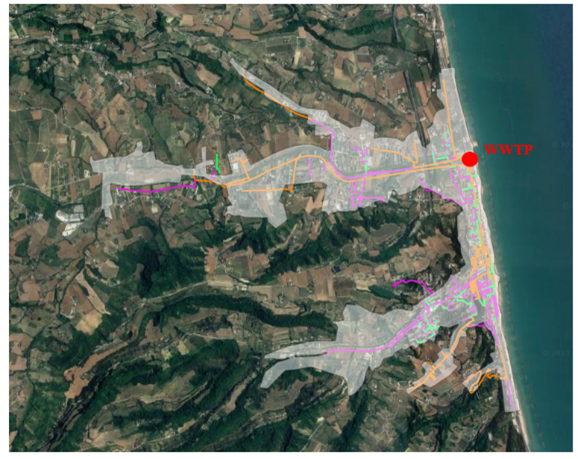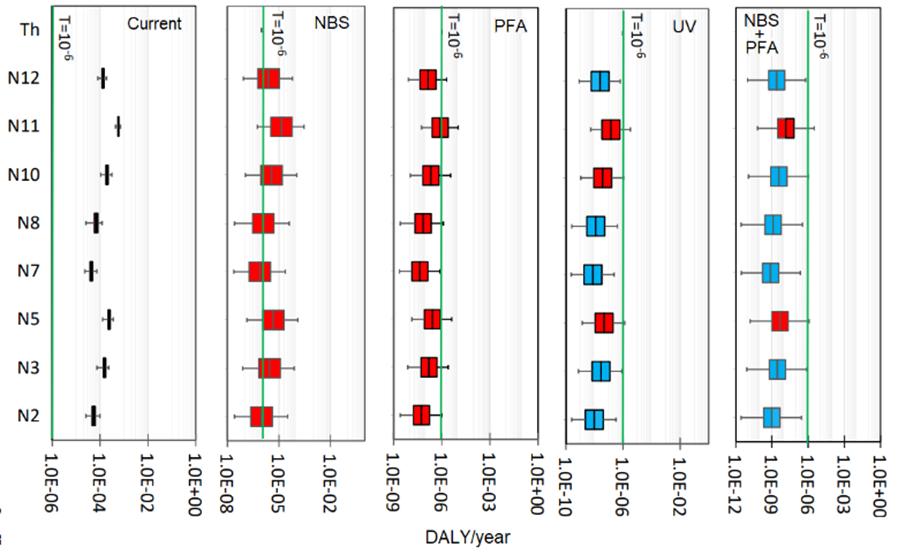UNIVPM is the lead of Work Package 5 (WP5 - Risk management tool & guidance for decision making) of WATERUN project, which aims at developing a new methodology for stormwater management based on a risk assessment (QMRA and QCRA).
During the last month, a draft version of QMRA calculation tool was developed for the assessment of the microbiological risk related to stormwater re-use to support stakeholders in decision-making process. Risk assessment is performed according to existing international guidelines, including Australian Guidelines for stormwater reuse and WHO documents.
QMRA calculation is accomlished by a python code, which is able to calculate the microbiological risk for specific reuse scenarios (e.g., garden irrigation, toilet flushing) and for three different pathogens (Campylobacter, Rotavirus, Cryptospordium). Furthermore, a preliminary version of a graphical user interface (GUI) has been created to allow the communication of a stormwater management model (SWMM) outputs with the phyton tool. More in detail, the developed tool allows to perform QMRA for a series of simulated rainfall events, and Monte Carlo techniques are implemented to increase the statistical reliability of the outcomes. Furthermore, this risk-based tool allows to evaluate the reduction of the health-risk after the implementation of different preventive measures to treat stormwater and remove pathogens. These measures can be directly selected by users, through the application of different pathogen log removals obtained by literature analysis.

Figure 1: GUI interface for QMRA calculation
The QMRA tool was tested in an Italian Case Study, the municipality of Cupra Maritimma, located in the South of Marche Region (central Italy), in order to evaluate the quality of occurring sewer overflows during different precipitation events. Outputs of the QMRA analysis provided indications about reuse possibilities of treated and untreated sewer discharges. In Figure 3, the risk for Campylobacter infections was calculated in terms of DALY/year in the untreated streams and after treatment with nature based solutions and disinfecion (performic acid – PFA, and UV irradiation).

Figure 2: Sewage network catchment in Cupra Marittima

Figure 3: DALY/year for: a) current, b) NBS, c) PFA, d) UV, e) NBS+PFA
These preliminary results were presented at ECOMONDO – Italian Exibition 2023 in Rimini for the topic " The challenges of the revised Urban WasteWater Treatment Directive".
Authors:
Francesco Fatone, Università Politecnica Delle Marche, f.fatone@univpm.it
Anna Laura Eusebi, Università Politecnica Delle Marche, a.l.eusebi@univpm.it
Massimiliano Sgroi, Università Politecnica Delle Marche, m.sgroi@univpm.it
Lucia De Simoni, Università Politecnica Delle Marche, l.desimoni@pm.univpm.it
Debora Jareta magna, Università Politecnica delle Marche, debora.jaretamagna@phd.unict.it
Bartosz Zelag, Kielce University of Technology, bartoszszelag@op.pl
Adam Kiczko, Warsaw University of Life Sciences, adam_kiczko@sggw.edu.pl
(16 November 2023)